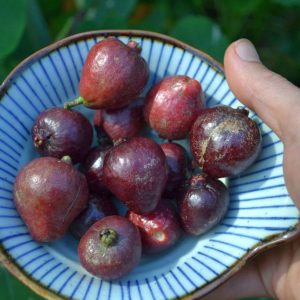How to grow cherry/strawberry/cattley guava
Jian Liu, from Camberwell, has her own website, called Melbourne Foodforest, where she writes articles to help people to develop their own food forests. In 2022, she published an article about why and how to grow cherry guava. Here she summarises that article.
 [Editor: there are a number of different fruit trees that are called guavas. In addition to the cherry/strawberry/cattley guava (Psidium cattleyanum), there is the apple/lemon/common guava (Psidium guajava), the purple guava (Psidium rufum), the Chilean guava (Ugni molinae) and the pineapple guava or feijoa (Feijoa sellowiana). Furthermore, the cherry/strawberry/cattley guava has both red-fruiting (P. cattleyanum var. cattleyanum) and yellow-fruiting (P. cattleyanum var. littorale) varieties.]
[Editor: there are a number of different fruit trees that are called guavas. In addition to the cherry/strawberry/cattley guava (Psidium cattleyanum), there is the apple/lemon/common guava (Psidium guajava), the purple guava (Psidium rufum), the Chilean guava (Ugni molinae) and the pineapple guava or feijoa (Feijoa sellowiana). Furthermore, the cherry/strawberry/cattley guava has both red-fruiting (P. cattleyanum var. cattleyanum) and yellow-fruiting (P. cattleyanum var. littorale) varieties.]
Cherry/strawberry/cattley guava (Psidium cattleyanum) is an evergreen tree or shrub that is native to Brazil. It can be planted virtually anywhere and it will likely flourish, including in those tricky dry shady positions in the lower canopy of your food forest.
There are many reasons to grow cherry/strawberry guava:
- It is a prolific producer of plump deep purple berries, a bit larger than a cherry in size. They are sweet and juicy. They are also highly nutritious, being a source of Vitamins A and C, fibre, omega 3 and 6 fatty acids, trace minerals and antioxidants.
- It is a pretty evergreen tree with glossy leaves and attractive bark. It can be grown as a dense hedge or in a tree form. It produces fluffy yellow-white flowers in the warmer seasons.
- It is not cold-sensitive like other, more ‘tropical’, guavas and can handle mild frosts and temperatures down to -5degC.
- It is drought tolerant and should be ok even without any supplemental water during the summer.
- It is disease-free, with no pests that bother it.
- It is not fussy about soil types and will happily grow in soils high in salt, sandy, clay soil or high pH limestone soils.
- It has a long fruiting season, giving you a steady harvest over late spring / early summer to early winter.
- It will fruit in its second to third year, so great for impatient gardeners.
- It will grow happily in either full sun and shade.
The fruit is juicy and sweet, with strawberry undertones. It has a delicate texture and a custardy inside similar to other guavas. The fruit has tiny pips and is safe to eat for young children. You can simply crunch through the pips (surprisingly fun!) or spit them out.
The fruit should ideally be eaten when deep purple, soft to the touch and when it has a strong strawberry aroma. At this stage it has developed all its sugars and a rich flavour. Picked earlier, when pale pink, you will find that it is quite tart and doesn’t have the same complexity of flavour. The longer you leave the fruit on the tree, the deeper the colour and the sweeter the taste. Eventually they will drop off the bush, so remember to look on the ground for any ripe fruit.

Can they be put thru the Fowlers preserving method? Would they have a shelf life done this way, or not successful?
What a great article by Jian Lui. As a Victorian, it is super helpful to hear the elements of how a food source can grow in local climate conditions. Got given half a doz of these tiny cherry guava, so will attempt to grow from seed. Thanks so much for the inspiration and intel on this fantastic little plant.